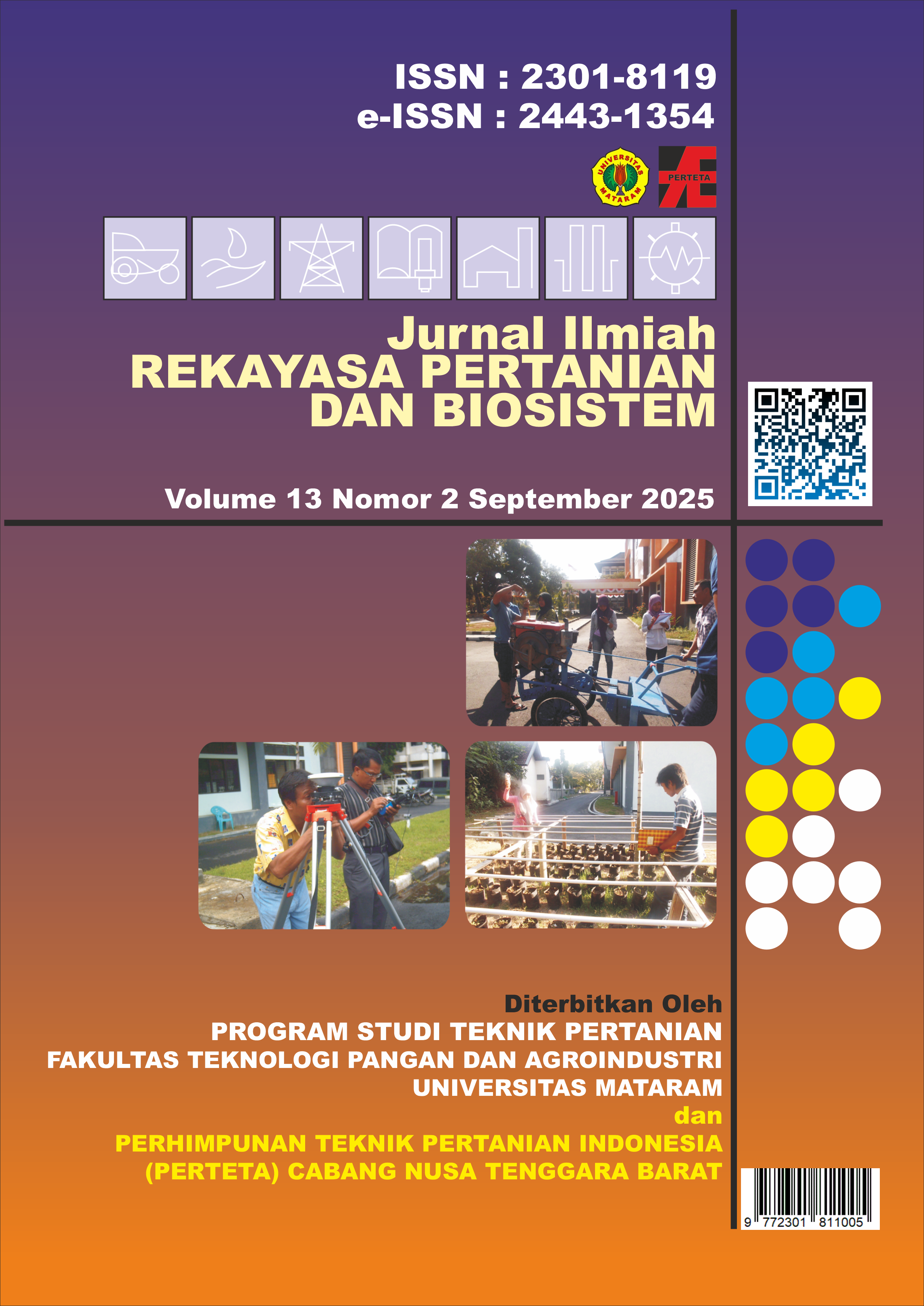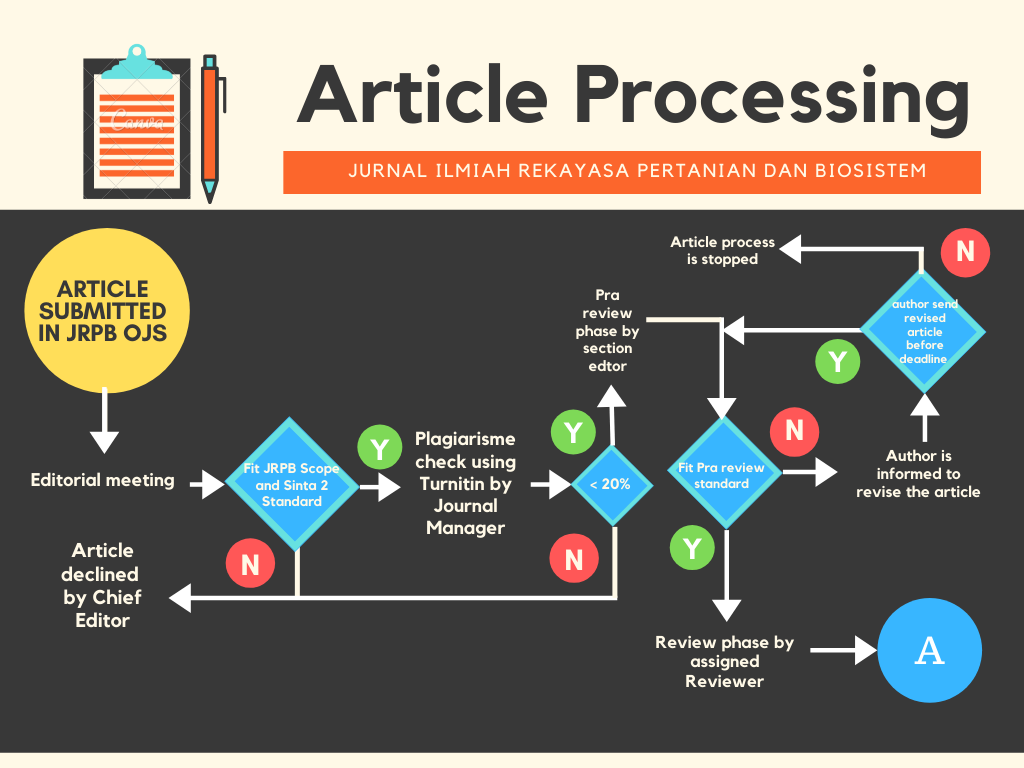Karakteristik Fisik Ekstrudat dengan Perlakuan Penambahan Tepung Sagu pada Grits Jagung dan Suhu Barrel
Authors
Anggun Devi Yunistiana , Joko Nugroho Wahyu Karyadi , Devi Yuni Susanti , Iftinan Aribah Rati Inayah , Roihan Syafiq Mufadhol , Ailsa Saraswati Samodra , Dwi AyuniDOI:
10.29303/jrpb.v13i2.1147Published:
2025-09-29Issue:
Vol. 13 No. 2 (2025): Jurnal Ilmiah Rekayasa Pertanian dan BiosistemKeywords:
corn grits, extrusion, physical characteristics, sago flour, snackArticles
Downloads
How to Cite
Downloads
Abstract
The technology that is widely used in making snacks is extrusion. Most commercially available extruded products use corn grit as the main ingredient. Corn grits can be combined with high-starch ingredients such as sago. Sago has great potential to be developed considering that sago production in Indonesia is very high, but its use is still limited. Sago is usually only processed as traditional food, so further innovation is needed. Therefore, this research aims to examine the effect of sago composition (0%, 10%, 20%, 30%) and barrel temperature (120⁰C, 130⁰C, 140⁰C) on the characteristics of extrudates made from corn grit and sago starch. The extrusion process was carried out with a SYSLG-IV twin screw extruder. it was found that increasing the proportion of sago starch and barrel temperature causes an increase in the expansion ratio (3.21-3.81), WSI (2.78-11.49) and a decrease in water content (7.15-10.16), particle density (0.13-0.22), bulk density (0.07-0.11), WAI (5.94-6.6), and hardness (3.59-5.96). The best treatment based on TOPSIS analysis was the sample with a sago composition ratio of 30% and a temperature of 140⁰C
References
Abdul Alam, N. A., Karim, R., & Muhammad, K. (2018). Effect of sago and tapioca starches
on the physicochemical and textural properties of expanded rice product coloured with
red beetroot (Beta vulgaris) powder. International Food Research Journal, 25(1), 21–27.
Ajita, T., & Jha, S. K. (2017). Extrusion cooking technology: Principal mechanism and effect on
direct expanded snacks - An overview. International Journal of Food Studies, 6(1), 113–128.
https://doi.org/10.7455/ijfs/6.1.2017.a10 DOI: https://doi.org/10.7455/ijfs/6.1.2017.a10
Alam, M. S., Kaur, J., Khaira, H., & Gupta, K. (2016). Extrusion and Extruded Products : Changes
in Quality Attributes as Affected by Extrusion Process Parameters : A Review Extrusion and
Extruded Products : Changes in Quality Attributes as Affected by Extrusion Process Parameters :
A Review. 8398. https://doi.org/10.1080/10408398.2013.779568 DOI: https://doi.org/10.1080/10408398.2013.779568
Altaf, U., Hussain, S. Z., Qadri, T., Iftikhar, F., Naseer, B., & Rather, A. H. (2021). Investigation
on mild extrusion cooking for development of snacks using rice and chickpea flour
blends. Journal of Food Science and Technology, 58(3), 1143–1155.
https://doi.org/10.1007/s13197-020-04628-7 DOI: https://doi.org/10.1007/s13197-020-04628-7
Ambarwati, K., Syamsir, E., & Yasni, S. (2022). Karakteristik Mi Berbasis Ubi Jalar dengan
Substitusi Pati Sagu atau Pati Ubi Banggai. Jurnal Teknologi Dan Industri Pangan, 33(1),
–20. https://doi.org/10.6066/jtip.2022.33.1.11 DOI: https://doi.org/10.6066/jtip.2022.33.1.11
Ansharullah, A., Wahyuni, S., Tamrin, ., & Natsir, M. (2020). Response Surface Method in
Evaluating the Extrusion Effects on Molecular Degradation and Physical Properties of
Sago Starch. Journal of Scientific Research and Reports, 26(8), 1–10.
https://doi.org/10.9734/jsrr/2020/v26i830292 DOI: https://doi.org/10.9734/jsrr/2020/v26i830292
Budijanto, S., & Yuliyanti. (2012). Study of Preparation Sorghum Flour and Application for
Analogues Rice Production Slamet. Jurnal Teknologi Pertanian Vol., 13(3), 177–186.
Budiman, Wulandari, Z., & Suryati, T. (2009). Suplementasi Tepung Putih Telur untuk
Memperbaiki Nilai Nutrisi Snack Ekstrusi Berbahan Grits Jagung. Media Peternakan,
(3), 179–184.
Dewandari, K. T., Mulyawanti, I., & Iriani, E. S. (2023). Strategi Peningkatan Pemanfaatan
Tepung Sagu Terstandar Pada Industri Mi. Warta BSIP Perkebunan, 1(3), 8–15.
Ding, Q. B., Ainsworth, P., Tucker, G., & Marson, H. (2005). The effect of extrusion conditions
on the physicochemical properties and sensory characteristics of rice-based expanded
snacks. Journal of Food Engineering, 66(3), 283–289.
https://doi.org/10.1016/j.jfoodeng.2004.03.019 DOI: https://doi.org/10.1016/j.jfoodeng.2004.03.019
Direktorat Jenderal Perkebunan Kementerian Pertanian. (2023). Statistik Perkebunan Unggulan
Nasional. Kementrian Pertanian Republik Indonesia.
Ernawati, E., Heliawaty, & Diansari, P. (2018). Peranan makanan tradisional berbahan sagu
sebagai alternatif dalam pemenuhan gizi masyarakat: Kasus Desa Laba, Kecamatan
Masamba, Kabupaten Luwu Utara, Provinsi Sulawesi Selatan. Jurnal Sosial Ekonomi
Pertanian, 14(1), 31–40. DOI: https://doi.org/10.24198/jt.vol14n1.5
Faijah, Fadilah, Rt., & Nurmila (2020). Perbandingan tepung tapioka dan sagu pada
pembuatan briket kulit buah nipah (Nypafruticans). Jurnal Pendidikan Teknologi Pertanian,
(2), 201–210.
Gat, Y., & Ananthanarayan, L. (2015). Effect of extrusion process parameters and
pregelatinized rice flour on physicochemical properties of ready-to-eat expanded snacks.
Journal of Food Science and Technology, 52(5), 2634–2645. https://doi.org/10.1007/s13197-
-1378-7
Guzmán-ortiz, F. A., Hernández-sánchez, H., Yee-madeira, H., Martín-martínez, E. S., Roblesramírez, M. C., Rojas-lópez, M., Berríos, J. D. J., & Mora-escobedo, R. (2015). Physicochemical , nutritional and infrared spectroscopy evaluation of an optimized soybean / corn flour
extrudate. 52(July), 4066–4077. https://doi.org/10.1007/s13197-014-1485-5 DOI: https://doi.org/10.1007/s13197-014-1485-5
Hakim, A. R., Handoyo, W. T., Novianto, T. D., & Prasetyo, A. W. (2019). Effects of TwinScrew Extruders Condition to Physical Properties of Floating Fish Feed. Jurnal Perikanan
Universitas Gadjah Mada, 21(2), 79. https://doi.org/10.22146/jfs.44821 DOI: https://doi.org/10.22146/jfs.44821
Islamiyah, S. S. (2009). SIFAT FISIK DAN SENSORI SNACK EKSTRUSI DENGAN
PENAMBAHAN TEPUNG DAGING-TULANG LEHER AYAM PEDAGING (TDTLA).
INSTITUT PERTANIAN BOGOR.
Kantrong, H., Charunuch, C., & Limsangouan, N. (2018). Influence of process parameters on
physical properties and specific mechanical energy of healthy mushroom-rice snacks and
optimization of extrusion process parameters using response surface methodology.
Journal of Food Science and Technology, 55(9), 3462–3472. https://doi.org/10.1007/s13197-
-3271-2
Lalujan, L. E., Djarkasi, G. S. S., Tuju, T. J. N., Rawung, D., Sumual, M. F., Ilmu, P., Pangan, T.,
Teknologi, J., Fakultas Pertanian, P., Sam, U., & Manado, R. (2017). Komposisi Kimia Dan
Gizi Jagung Lokal Varietas “Manado Kuning” Sebagai Bahan Pangan Pengganti Beras.
Jurnal Teknologi Pertanian, 8(1), 47–54.
Mani, R., & Bhattacharya, M. (1998). Properties of injection moulded starch/synthetic polymer
blends - III. Effect of amylopectin to amylose ratio in starch. European Polymer Journal,
(10), 1467–1475.
Minweyelet, M., Solomon, W. K., & Bultosa, G. (2021). Effects of extrusion operating
conditions and blend proportion on the physico-chemical and sensory properties of teffrice blend extruded products. Food Research, 5(2), 173–183.
https://doi.org/10.26656/fr.2017.5(2).467 DOI: https://doi.org/10.26656/fr.2017.5(2).467
Nor, N. M., Carr, A., Hardacre, A., & Brennan, C. S. (2013). The development of expanded
snack product made from pumpkin flour-corn grits: Effect of extrusion conditions and
formulations on physical characteristics and microstructure. Foods, 2(2), 160–169.
https://doi.org/10.3390/foods2020160 DOI: https://doi.org/10.3390/foods2020160
Nurilmala, M., Suptijah, P., Subagja, Y., & Hidayat, T. (2014). Utilization and Fortification of
Patin Fish on Extrusion Snack. Jurnal Pengolahan Hasil Perikanan Indonesia, 17(2), 175–185.
https://doi.org/10.17844/jphpi.v17i2.8721 DOI: https://doi.org/10.17844/jphpi.v17i2.8721
Pakpahan, N., & Nelinda. (2019). Studi Karakteristik Kerupuk: Pengaruh Komposisi dan DOI: https://doi.org/10.35308/jtpp.v1i1.1484
Proses Pengolahan. Teknologi Pengolahan Pertanian, 1(1), 28–38.
Pathak, N., & Kochhar, A. (2018). Extrusion Technology: Solution to Develop Quality Snacks
for Malnourished Generation. International Journal of Current Microbiology and Applied
Sciences, 7(1), 1293–1307. https://doi.org/10.20546/ijcmas.2018.701.158 DOI: https://doi.org/10.20546/ijcmas.2018.701.158
Pelembe, L. A. M., Erasmus, C., & Taylor, J. R. N. (2002). Development of a protein-rich
composite sorghum - Cowpea instant porridge by extrusion cooking process. Lwt, 35(2),
–127. https://doi.org/https://doi.org/10.1006/fstl.2001.0812 DOI: https://doi.org/10.1006/fstl.2001.0812
Pudjihastuti, I., Supriyo, E., & Devara, H. R. (2021). Pengaruh Rasio Bahan Baku Tepung
Komposit (Ubi Kayu, Jagung Dan Kedelai Hitam) Pada Kualitas Pembuatan Beras
Analog. Gema Teknologi, 21(2), 61–66. https://doi.org/10.14710/gt.v21i2.32923 DOI: https://doi.org/10.14710/gt.v21i2.32923
Oktavianasari, R. R., Damat, D., & Manshur, H. A. (2023). Kajian Karakteristik Fisikokimia
dan Organoleptik Beras Analog Berbahan Dasar Tepung Gembili (Dioscorea aculleata.
L), Tepung Jagung (Zea mays, L) dan Pati Sagu (Metroxylon sp). Food Technology and
Halal Science Journal, 5(2), 125–136. https://doi.org/10.22219/fths.v5i2.21911 DOI: https://doi.org/10.22219/fths.v5i2.21911
Rahardjo, E. M. W. B. (2019). Physico-Chemical and Sensory Characteristics of Dried Noodles With
Substitution of Composite Flour (Sago and Banana “Kepok” Flour). UNIKA
SOEGIJAPRANATA SEMARANG.
Seth, D., Badwaik, L. S., & Ganapathy, V. (2015). Effect of feed composition, moisture content
and extrusion temperature on extrudate characteristics of yam-corn-rice based snack
food. Journal of Food Science and Technology, 52(3), 1830–1838.
https://doi.org/10.1007/s13197-013-1181-x DOI: https://doi.org/10.1007/s13197-013-1181-x
Sharifi, S., Majzoobi, M., & Farahnaky, A. (2021). Effects of particle size and moisture content
of maize grits on physical properties of expanded snacks. Journal of Texture Studies, 52(1),
–123. https://doi.org/10.1111/jtxs.12565 DOI: https://doi.org/10.1111/jtxs.12565
Shevkani, K., Kaur, A., Singh, G., Singh, B., & Singh, N. (2014). Composition, Rheological and
Extrusion Behaviour of Fractions Produced by Three Successive Reduction Dry Milling
of Corn. Food and Bioprocess Technology, 7(5), 1414–1423. https://doi.org/10.1007/s11947-
-1194-5
Singh, B., Rachna, Hussain, S. Z., & Sharma, S. (2015). Response Surface Analysis and Process
Optimization of Twin Screw Extrusion Cooking of Potato-Based Snacks. Journal of Food
Processing and Preservation, 39(3), 270–281. https://doi.org/10.1111/jfpp.12230 DOI: https://doi.org/10.1111/jfpp.12230
Tongdang, T., Meenun, M., & Chainui, J. (2008). Effect of sago starch addition and steaming
time on making cassava cracker (Keropok). Starch‐Stärke, 60(10), 568–576.
Utami, D., & Widyaningsih, T. D. (2015). Pengembangan snack ekstrudat berbasis ubi jalar
oranye tersubstitusi tempe kacang tunggak sebagai sumber protein. Jurnal Pangan Dan
Agroindustri Vol., 3(2), 620–630.
Utari, K. S. T., Dewi, E. N., & Romadhon. (2016). Physicochemical Characteristics of Extruded
Fish-Snack Tilapia (Oreochromis niloticus) with Grit of Large- leafed Mangrove
(Bruguiera gymnorrhiza) Addition. J. Peng. & Biotek. Hasil Pi., 5(4), 33–42.
Vanier, N. L., dos Santos, J. P., Villanova, F. A., Colussi, R., Elias, M. C., Pan, J., & Berrios, J.
D. J. (2018). Effects of rice amylose content and processing conditions on the quality of
rice and bean-based expanded extrudates. Journal of Food Processing and Preservation,
(9). https://doi.org/10.1111/jfpp.13758 DOI: https://doi.org/10.1111/jfpp.13758
Yusuf, M., Halilu, M., & Filli, K. (2018). Influence of Extrusion Variables on Proximate
Composition Some Nutrient and Antinutrient Contents of Dakuwa Extrudates Produced
from Blends of Sorghum (Sorghum bicolour L) Groundnut (Arachis hypogea L) and
Tigernut (Cyperus esculentus). Current Journal of Applied Science and Technology, 26(4), 1–
https://doi.org/10.9734/cjast/2018/40037 DOI: https://doi.org/10.9734/CJAST/2018/40037
Zambrano, Y., Contardo, I., & Bouchon, P. (2022). Effect of Extrusion Temperature and Feed
Moisture Content on the Microstructural Properties of Rice-Flour Pellets and Their Impact on
the Expanded Product.
Zhu, L., Shukri, R., Mesa-stonestreet, N. J. De, & Alavi, S. (2010). Mechanical and
microstructural properties of soy protein – high amylose corn starch extrudates in
relation to physiochemical changes of starch during extrusion. Journal of Food Engineering,
(2), 232–238. https://doi.org/10.1016/j.jfoodeng.2010.04.004 DOI: https://doi.org/10.1016/j.jfoodeng.2010.04.004
License
Copyright (c) 2025 Anggun Devi Yunistiana, Joko Nugroho Wahyu Karyadi, Devi Yuni Susanti, Iftinan Aribah Rati Inayah, Roihan Syafiq Mufadhol, Ailsa Saraswati Samodra

This work is licensed under a Creative Commons Attribution-ShareAlike 4.0 International License.
Authors who publish with this journal agree to the following terms:
- Authors retain copyright and grant the journal right of first publication with the work simultaneously licensed under a Creative Commons Attribution License 4.0 International License (CC-BY-SA License). This license allows authors to use all articles, data sets, graphics, and appendices in data mining applications, search engines, web sites, blogs, and other platforms by providing an appropriate reference. The journal allows the author(s) to hold the copyright without restrictions and will retain publishing rights without restrictions.
- Authors are able to enter into separate, additional contractual arrangements for the non-exclusive distribution of the journal's published version of the work (e.g., post it to an institutional repository or publish it in a book), with an acknowledgement of its initial publication in Jurnal Ilmiah Rekayasa Pertanian dan Biosistem (JRPB).
- Authors are permitted and encouraged to post their work online (e.g., in institutional repositories or on their website) prior to and during the submission process, as it can lead to productive exchanges, as well as earlier and greater citation of published work (See The Effect of Open Access).










